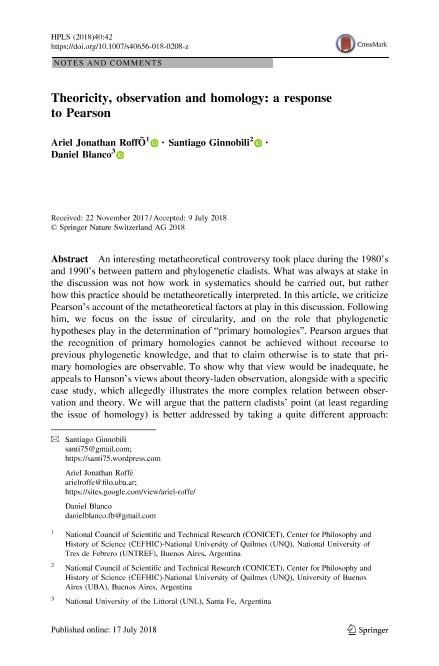Mostrar el registro sencillo del ítem
dc.contributor.author
Roffé, Ariel Jonathan

dc.contributor.author
Ginnobili, Santiago

dc.contributor.author
Blanco, Daniel
dc.date.available
2020-02-21T20:15:47Z
dc.date.issued
2018-09
dc.identifier.citation
Roffé, Ariel Jonathan; Ginnobili, Santiago; Blanco, Daniel; Theoricity, observation and homology: a response to Pearson; Springer; History and Philosophy of the Life Sciences; 40; 3; 9-2018; 1-8
dc.identifier.issn
0391-9714
dc.identifier.uri
http://hdl.handle.net/11336/98341
dc.description.abstract
An interesting metatheoretical controversy took place during the 1980’s and 1990’s between pattern and phylogenetic cladists. What was always at stake in the discussion was not how work in systematics should be carried out, but rather how this practice should be metatheoretically interpreted. In this article, we criticize Pearson’s account of the metatheoretical factors at play in this discussion. Following him, we focus on the issue of circularity, and on the role that phylogenetic hypotheses play in the determination of “primary homologies”. Pearson argues that the recognition of primary homologies cannot be achieved without recourse to previous phylogenetic knowledge, and that to claim otherwise is to state that primary homologies are observable. To show why that view would be inadequate, he appeals to Hanson’s views about theory-laden observation, alongside with a specific case study, which allegedly illustrates the more complex relation between observation and theory. We will argue that the pattern cladists’ point (at least regarding the issue of homology) is better addressed by taking a quite different approach: instead of thinking in terms of observability, the topic can be tackled by paying attention to the way in which concepts are determined. We will take the notion of T-theoricity from metatheoretical structuralism and show that, once the issue is discussed with the appropriate metatheoretical framework, the alleged counterexample brought up by Pearson is not problematic at all for pattern cladism.
dc.format
application/pdf
dc.language.iso
eng
dc.publisher
Springer

dc.rights
info:eu-repo/semantics/openAccess
dc.rights.uri
https://creativecommons.org/licenses/by-nc-sa/2.5/ar/
dc.subject
CLADISTICS
dc.subject
EVOLUTIONARY THEORY
dc.subject
HOMOLOGY
dc.subject
METATHEORETICAL STRUCTURALISM
dc.subject
PATTERN CLADISTICS
dc.subject
T-THEORICITY
dc.subject.classification
Filosofía, Historia y Filosofía de la Ciencia y la Tecnología

dc.subject.classification
Filosofía, Ética y Religión

dc.subject.classification
HUMANIDADES

dc.title
Theoricity, observation and homology: a response to Pearson
dc.type
info:eu-repo/semantics/article
dc.type
info:ar-repo/semantics/artículo
dc.type
info:eu-repo/semantics/publishedVersion
dc.date.updated
2020-02-18T16:06:35Z
dc.journal.volume
40
dc.journal.number
3
dc.journal.pagination
1-8
dc.journal.pais
Italia

dc.journal.ciudad
Nápoles
dc.description.fil
Fil: Roffé, Ariel Jonathan. Universidad Nacional de Tres de Febrero; Argentina. Universidad Nacional de Quilmes; Argentina. Consejo Nacional de Investigaciones Científicas y Técnicas; Argentina
dc.description.fil
Fil: Ginnobili, Santiago. Consejo Nacional de Investigaciones Científicas y Técnicas; Argentina. Universidad Nacional de Quilmes; Argentina. Universidad de Buenos Aires; Argentina
dc.description.fil
Fil: Blanco, Daniel. Universidad Nacional del Litoral; Argentina
dc.journal.title
History and Philosophy of the Life Sciences

dc.relation.alternativeid
info:eu-repo/semantics/altIdentifier/url/https://link.springer.com/article/10.1007%2Fs40656-018-0208-z
dc.relation.alternativeid
info:eu-repo/semantics/altIdentifier/doi/https://doi.org/10.1007/s40656-018-0208-z
Archivos asociados
